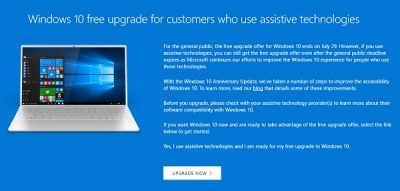Microsoft’s Windows 10 OS comes with a lot of new features and latest technological advancements. Microsoft’s goal about its latest OS is that by 2018, at least a billion devices would be running Windows 10. To attain this goal, Microsoft also offered Windows 10 OS upgraded for free for one year so that more and more users could shift from older versions to Windows 10. All this is great; now, however, some concerns are being raised on infringement of two important aspects; i.e. user choice and user privacy. Is Microsoft really crossing the lines in terms of user choice and privacy when it comes to Windows 10 OS? Well, at least Electronic Frontier Foundation feels so.

Is Microsoft dismissing user choice and privacy with Windows 10 OS
The blog post focusses on examining the software giant’s strategy behind deploying Windows 10 OS. This mainly revolves around disregarding user choice and user privacy. The blog says, that the methods Microsoft used to get users of earlier versions of Windows to upgrade to Windows 10 OS were quite similar to malicious activities. For example,
“Microsoft installed an app in users’ system trays advertising the free upgrade to Windows 10. The app couldn’t be easily hidden or removed, but some enterprising users figured out a way. Then, the company kept changing the app and bundling it into various security patches, creating a cat-and-mouse game to uninstall it.”
After this, Microsoft started pushing Windows 10 OS via its Windows Update system. The download for new OS was pre-selected, which downloaded the OS on their machines. In addition to this, Windows 10 OS became a recommended update so that the users receiving critical security updates could also download the Windows 10; apparently, without their knowledge. The blog mentions several other such incidences and examples, as per which the users were not given any other choice, but to download Windows 10 OS. Apparently, many users who did not want Windows 10 OS also needed to download it due as there was no other choice given to them.
Regarding disregarding users’ privacy, the blog mentions that:
“By default, Windows 10 OS sends an unprecedented amount of usage data back to Microsoft, and the company claims most of it is to “personalize” the software by feeding it to the OS assistant called Cortana. Here’s a non-exhaustive list of data sent back: location data, text input, voice input, touch input, the web pages you visit, and telemetry data regarding your general usage of your computer, including which programs you run and for how long.”
It concludes by saying:
Microsoft should come clean with its user community. The company needs to acknowledge its missteps and offer real, meaningful opt-outs to the users who want them, preferably in a single unified screen. It also needs to be straightforward in separating security updates from operating system upgrades going forward, and not try to bypass user choice and privacy expectations. Otherwise it will face backlash in the form of individual lawsuits, state attorney general investigations, and government investigations.
Well, some of the claims by the blog about Windows 10 privacy issues may seem to be correct. However, are they really a problem or Microsoft is trying to make users’ life easier with those, that’s a question.
Read the complete blog by EFF here.
It’s high time that Microsoft is taught a lesson in decency.
W10 is a failure, consumers don’t like it, business even less. American crap.
I only agree that Microsoft shouldn’t be so free with privacy issues.
On the other hand, Windows 10 does NOT seem to be the unliked, failure OS you paint it to be.
If the global and dominate OS came from Timbuktu, Mali, it wouldn’t make it any more or less “crap”. You’re, of course, free to like and use it…or not. Cheers!
American Crap?
Maybe it has it’s flaws but I have yet to see ONE European, Asian or Middle Eastern Community/Nation create a replacement Operating System that is any better or can replace it on a world wide scale.
So either own up to the fact that The United States creates civilization changing technology and ideas while European Socialism gives you absolutely nothing but hug each other.
Those hugs by Merkel has really helped the German people not get assaulted by Muslim Immigrants.